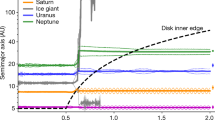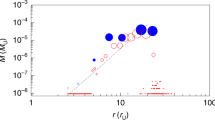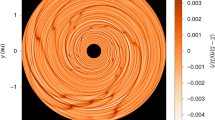Abstract
The Moon is generally thought to have formed from the debris ejected by the impact of a planet-sized object with the proto-Earth towards the end of planetary accretion1,2. Models of the impact process predict that the lunar material was disaggregated into a circumplanetary disk and that lunar accretion subsequently placed the Moon in a near-equatorial orbit3,4,5,6. Forward integration of the lunar orbit from this initial state predicts a modern inclination at least an order of magnitude smaller than the lunar value—a long-standing discrepancy known as the lunar inclination problem7,8,9. Here we show that the modern lunar orbit provides a sensitive record of gravitational interactions with Earth-crossing planetesimals that were not yet accreted at the time of the Moon-forming event. The currently observed lunar orbit can naturally be reproduced via interaction with a small quantity of mass (corresponding to 0.0075–0.015 Earth masses eventually accreted to the Earth) carried by a few bodies, consistent with the constraints and models of late accretion10,11. Although the encounter process has a stochastic element, the observed value of the lunar inclination is among the most likely outcomes for a wide range of parameters. The excitation of the lunar orbit is most readily reproduced via collisionless encounters of planetesimals with the Earth–Moon system with strong dissipation of tidal energy on the early Earth. This mechanism obviates the need for previously proposed (but idealized) excitation mechanisms12,13, places the Moon-forming event in the context of the formation of Earth, and constrains the pristineness of the dynamical state of the Earth–Moon system.
This is a preview of subscription content, access via your institution
Access options
Subscribe to this journal
Receive 51 print issues and online access
$199.00 per year
only $3.90 per issue
Buy this article
- Purchase on Springer Link
- Instant access to full article PDF
Prices may be subject to local taxes which are calculated during checkout



Similar content being viewed by others
References
Cameron, A. G. W. & Ward, W. R. The origin of the Moon. Lunar Planet. Sci. Conf. 7, abstr. 120–122 (1976)
Hartmann, W. K. & Davis, D. R. Satellite-sized planetesimals and lunar origin. Icarus 24, 504–515 (1975)
Cuk, M. & Stewart, S. T. Making the Moon from a fast-spinning Earth: a giant impact followed by resonant despinning. Science 338, 1047–1052 (2012)
Canup, R. M. & Asphaug, E. Origin of the Moon in a giant impact near the end of the Earth’s formation. Nature 412, 708–712 (2001)
Canup, R. M. Forming a Moon with an Earth-like composition via a giant impact. Science 338, 1052–1055 (2012)
Ida, S., Canup, R. M. & Stewart, G. R. Lunar accretion from an impact-generated disk. Nature 389, 353–357 (1997)
Mignard, F. The lunar orbit revisited, III. Moon Planets 24, 189–207 (1981)
Goldreich, P. History of lunar orbit. Rev. Geophys. 4, 411–439 (1966)
Touma, J. & Wisdom, J. Evolution of the Earth–Moon system. Astron. J. 108, 1943–1961 (1994)
Bottke, W. F., Walker, R. J., Day, J. M. D., Nesvorny, D. & Elkins-Tanton, L. Stochastic late accretion to Earth, the Moon, and Mars. Science 330, 1527–1530 (2010)
Raymond, S. N., Schlichting, H. E., Hersant, F. & Selsis, F. Dynamical and collisional constraints on a stochastic late veneer on the terrestrial planets. Icarus 226, 671–681 (2013)
Touma, J. & Wisdom, J. Resonances in the early evolution of the Earth-Moon system. Astron. J. 115, 1653–1663 (1998)
Ward, W. R. & Canup, R. M. Origin of the Moon’s orbital inclination from resonant disk interactions. Nature 403, 741–743 (2000)
Thompson, C. & Stevenson, D. J. Gravitational instability in two-phase disks and the origin of the Moon. Astrophys. J. 333, 452–481 (1988)
Salmon, J. & Canup, R. M. Lunar accretion from a Roche-interior fluid disk. Astrophys. J. 760, 83 (2012)
Wisdom, J. & Tian, Z. L. Early evolution of the Earth–Moon system with a fast-spinning Earth. Icarus 256, 138–146 (2015)
Morbidelli, A., Marchi, S., Bottke, W. F. & Kring, D. A. A sawtooth-like timeline for the first billion years of lunar bombardment. Earth Planet. Sci. Lett. 355–356, 144–151 (2012)
Canup, R. M. Dynamics of lunar formation. Annu. Rev. Astron. Astrophys. 42, 441–475 (2004)
Nimmo, F. & Chen, E. M. A. Tidal dissipation in the early lunar magma ocean and its role in the evolution of the Earth-Moon system. 45th Lunar Planet. Sci. Conf. abstr. 1459 (2014)
Alemi, A. & Stevenson, D. J. Why Venus has no moon. Bull. Am. Astron. Soc. 38, 491 (2006)
Canup, R. M. Lunar-forming impacts: processes and alternatives. Philos. Trans. R. Soc. London Ser. A 372, 20130175 (2014)
Spurzem, R., Giersz, M., Heggie, D. C. & Lin, D. N. C. Dynamics of planetary systems in star clusters. Astrophys. J. 697, 458–482 (2009)
Walsh, K. J., Morbidelli, A., Raymond, S. N., O’Brien, D. P. & Mandell, A. M. A low mass for Mars from Jupiter’s early gas-driven migration. Nature 475, 206–209 (2011)
Wetherill, G. W. Collisions in the asteroid belt. J. Geophys. Res. 72, 2429–2444 (1967)
Yoder, C. F. & Peale, S. J. The tides of Io. Icarus 47, 1–35 (1981)
Kaula, W. M. Tidal dissipation by solid friction and the resulting orbital evolution. Rev. Geophys. 2, 661–685 (1964)
Wieczorek, M. A., Weiss, B. P. & Stewart, S. T. An impactor origin for lunar magnetic anomalies. Science 335, 1212–1215 (2012)
Collins, B. F. & Sari, R. Levy flights of binary orbits due to impulsive encounters. Astron. J. 136, 2552–2562 (2008)
Zahnle, K. J., Lupu, R., Dobrovolskis, A. & Sleep, N. H. The tethered Moon. Earth Planet. Sci. Lett. 427, 74–82 (2015)
Marchi, S., Bottke, W. F., Kring, D. A. & Morbidelli, A. The onset of the lunar cataclysm as recorded in its ancient crater populations. Earth Planet. Sci. Lett. 325–326, 27–38 (2012)
Acknowledgements
This research was carried out as part of a Henri Poincaré Fellowship at the Observatoire de la Côte d’Azur (OCA) to K.P. The Henri Poincaré Fellowship is funded by the OCA and the City of Nice, France. A.M. thanks the European Research Council Advanced Grant ACCRETE (no. 290568).
Author information
Authors and Affiliations
Contributions
K.P. and A.M. discussed every step of the project, designed the simulation set-up and co-wrote the numerical code. K.P. performed the simulations and the statistical analysis.
Corresponding author
Ethics declarations
Competing interests
The authors declare no competing financial interests.
Extended data figures and tables
Extended Data Figure 1 Properties of planetesimal populations.
a, Decay rates of Earth-crossing planetesimal populations according to N-body simulations of the inner Solar System with a resonant (3:2) Jupiter and Saturn at 5.4 AU and 7.2 AU, respectively. Different colours represent the number of Earth-crossing bodies (hence the evolution is not monotonic) in different simulations, from recent integrations17. The black line is the prescribed decay rate used in the three-body simulations (τSS = 44 Myr) to match the decay rate in heliocentric simulations. b, Histogram of implemented approach velocities (before acceleration due to Earth gravity) for late-accreting populations in three-body simulations. The population is generated using a Rayleigh distribution of eccentricities and inclinations (eR = 0.3, iR = eR/2) and a semi-major axis range (a = 0.8–1.4 AU) that produces Earth-crossing orbits. These parameters are motivated by simulations of terrestrial planet formation, but the peak of the distribution (9 km s−1) corresponds to the typical encounter velocity inferred for lunar basin-forming impactors30.
Extended Data Figure 2 Tests and outcomes for reproducibility.
a, Test of the cumulative effect of repeated encounters: median values (squares), and 1σ (solid lines) and 2σ (dashed lines) intervals for three suites of simulations with 0.0075ME accreted via a single body onto an Earth with strong dissipation (k2/Q = 0.1). Each suite of simulations consists of incoming planetesimals with impact parameters (b) ranging from 0 to RH, RH/2 and RH/4 (as indicated by the values given above each simulation result). The statistical similarity of the resultant distributions shows that distant encounters have a far smaller effect on inclination excitation than do the rare and strong close encounters. b, c, Distribution of ‘kicks’ versus impact parameter (b) of encounters from two different realizations. The change in the angular momentum vector of the satellite ( ) owing to encounter torques is normalized to the magnitude of the orbital angular momentum before the encounter (
) owing to encounter torques is normalized to the magnitude of the orbital angular momentum before the encounter ( ). The planetesimals approaching the Earth–Moon system in this simulation have a mass of 0.0075ME. Approach velocities are selected from the distribution plotted in Extended Data Fig. 1b. The cumulative effects of encounters with b > 60RE are negligible and therefore neglected. Panel b (c) shows data from a realization that lasts 26.2 Myr (45.3 Myr) and results in a satellite with a final inclination of i = 1.9° (i = 8.8°). The strength of tidal dissipation used here (k2/Q = 0.1) quickly results in a satellite semi-major axis of a = 30RE–40RE.
). The planetesimals approaching the Earth–Moon system in this simulation have a mass of 0.0075ME. Approach velocities are selected from the distribution plotted in Extended Data Fig. 1b. The cumulative effects of encounters with b > 60RE are negligible and therefore neglected. Panel b (c) shows data from a realization that lasts 26.2 Myr (45.3 Myr) and results in a satellite with a final inclination of i = 1.9° (i = 8.8°). The strength of tidal dissipation used here (k2/Q = 0.1) quickly results in a satellite semi-major axis of a = 30RE–40RE.
Extended Data Figure 3 Effect of partial damping due to LMO obliquity tides.
Median values (squares), and 1σ (solid lines) and 2σ (dashed lines) intervals for several suites of partially damped simulations. These simulations consist of an accreted mass of 0.0075ME delivered via a single body onto a strongly dissipative (k2/Q = 0.1) Earth, with the orbital excitation continuously reset (e = 0, i = 0) until a certain time and permitted to accumulate subsequently. Such a transition represents LMO crystallization and the cessation of inclination damping via obliquity tides19. These simulations are representative of excitation behaviour for partially damped cases. It can be seen that, so long as the crystallization of the LMO is sufficiently rapid (about 107 years), excitation via planetesimal encounters is largely unaffected.
Rights and permissions
About this article
Cite this article
Pahlevan, K., Morbidelli, A. Collisionless encounters and the origin of the lunar inclination. Nature 527, 492–494 (2015). https://doi.org/10.1038/nature16137
Received:
Accepted:
Published:
Issue Date:
DOI: https://doi.org/10.1038/nature16137
This article is cited by
-
Heterogeneous delivery of silicate and metal to the Earth by large planetesimals
Nature Geoscience (2018)
-
A multiple-impact origin for the Moon
Nature Geoscience (2017)
-
Tidal evolution of the Moon from a high-obliquity, high-angular-momentum Earth
Nature (2016)
-
2015 Editors' choice
Nature (2015)
-
The Moon's tilt for gold
Nature (2015)
Comments
By submitting a comment you agree to abide by our Terms and Community Guidelines. If you find something abusive or that does not comply with our terms or guidelines please flag it as inappropriate.



